上のカラフルな樹脂 3D プリントを少しだけ鑑賞してみましょう。樹脂を使用すると、あらゆる種類の 3D プリントのアイデアを実現できます。アイアンマン、キャプテン・アメリカ、ハルク、その他のスーパーヒーローなど、お気に入りのマーベルのキャラクターを簡単にプリントアウトして、コレクションとして自宅、職場、または好きな場所に飾ることができます。
しかし、市場にはさまざまな樹脂が市販されているので、どれを買えばよいのでしょうか?

今日は、どのPhrozen レジンが初心者や愛好家にとって最適であるかを知るためのスターター ガイドを提供します。
レジン 3D プリントを始めたばかりの方には、アクア シリーズ(ブルー、グリーン、グレー 4K 、およびアイボリー 4K )、 ABS ライク シリーズ( マット グレー、 クリーミー ホワイト)、 ベージュ フレックス、およびクリア レジンのレジンをお勧めします。
それぞれの樹脂の特徴と用途、用途について見ていきましょう。
アクアシリーズ
アクアグレー 4K およびアクアアイボリー 4K 樹脂 — 非常に詳細な 3D プリントに最適

フロゼン アクアグレー 4K およびAqua-Ivory 4K樹脂は、非常に高解像度のプリントを作成し、滑らかな表面と水平線のない非常に複雑な 3D プリント モデルのプリントアウトに最適です。アクアグレーの 4K 樹脂を使用して、上の写真のブラックパンサーの胸像は細部まですべて印刷され、3D プリントで可能な限りテクスチャーを表現することができました。
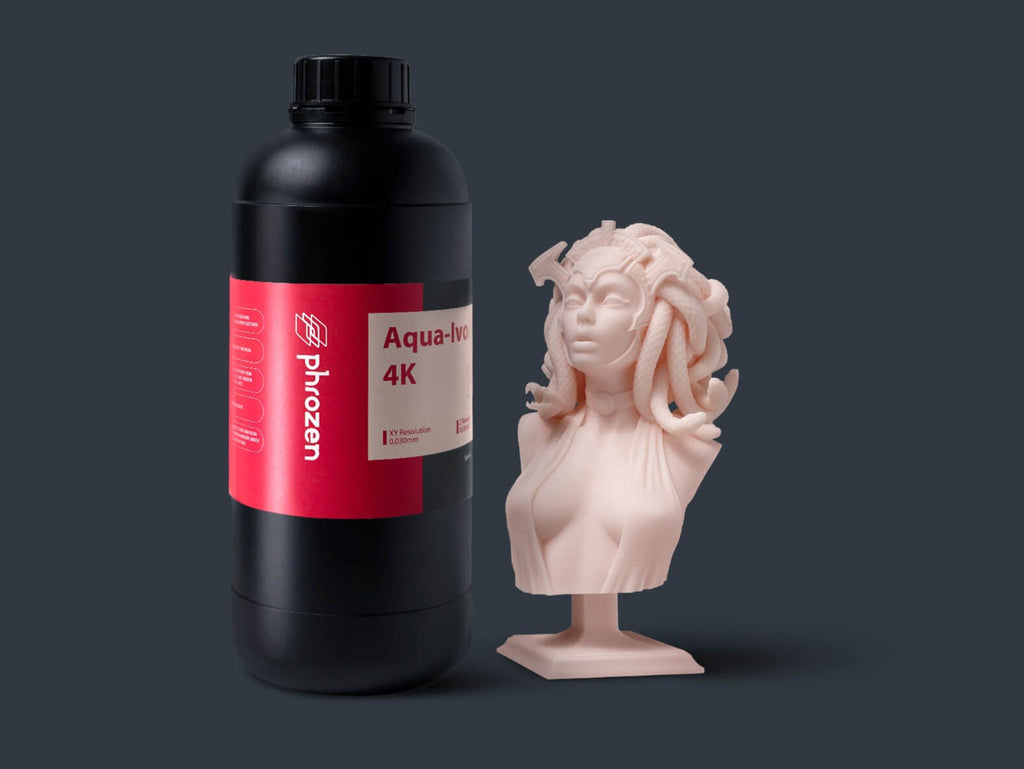 3D モデルのクレジット: Loot Studios
3D モデルのクレジット: Loot Studios
明るい色を備えた Aqua-Ivory 4K は、さまざまな色でペイントして 3D プリントを可能な限り本物に近づけるのに最適です。 Aqua-Ivory 4K は、Sonic Mighty 4K や Sonic Mega 8K などの大型 3D プリンタを使用して、大規模で詳細な 3D モデルをプリントアウトするのにも非常に適しています。
メーカーとして、非常に詳細で水平線のない 3D 印刷可能なモデルをプリントアウトしたい場合は、アクア グレー 4K およびアクア アイボリー 4K 樹脂が最良の選択となるでしょう。
この樹脂は、Phrozen LCD 3D プリンター: Sonic Mini 4K 、 Sonic Mighty 4K 、およびSonic Mega 8Kで最もよく機能します。
特徴:
Phrozen 4K レジンは、非常に高い精度で 3D モデルを生成します。粘度が低いため、印刷完了後の 3D プリントのすすぎや洗浄も簡単です。
特徴 (アクアグレー 4K):
粘度: 150cps
密度: 1.1
Tg(ガラス転移温度):68.4℃
表面硬度(ショアD):ショア77D
伸び(破断時):7%
引張強さ:2Mpa
アイゾッド衝撃: 6.78 KJ/m2
特徴 (アクアアイボリー 4K):
粘度: 221cps
密度: 1.1
表面硬度(ショアD):ショア75D
伸び(破断時):6%
引張強さ:1.9Mpa
アクアブルーおよびアクアグリーン樹脂 - カラフルな 3D プリントに最適

Phrozen Aqua-Blue 樹脂とAqua-Green 樹脂を使用すると、その明るい色により、人々の注目をすぐに集める鮮やかで派手な 3D モデルを印刷できます。上の写真にある、アクアグリーンの樹脂でプリントされたティラノサウルスを見てください。威圧的で生々しいように見えませんか?
アクアブルーとアクアグリーンのレジンは、通常のニュートラルなレジンの色の代わりに、すべての作品にポップな色をもたらすことができます。おまけに、印刷後にモデルをペイントする必要はありません。
特徴:
アクアブルーとアクアグリーンの樹脂はどちらも、脆くない 3D 印刷可能なモデルを簡単に作成できます。アクアブルーおよびアクアグリーン樹脂は、アクアグレー 4K 樹脂よりも引張強度、つまり圧力下での破壊に対する耐性が高くなります。
これら 2 つの樹脂は、すべての Phrozen 樹脂の中で最も収縮率が低いため、高精度の印刷に最適です。アクアグリーンとアクアブルーのレジンはどちらもアクアグレー 4K より粘度が低くなりますが、アクアグリーンの粘度はアクアブルーレジンよりわずかに低くなります。
特徴 (アクアブルー):
粘度: 130cps
密度:1.12
Tg(ガラス転移温度):82℃
表面硬度(ショアD):ショア86D
伸び(破断時):21%
引張強さ:24MPa
アイゾッド衝撃:1.81KJ/m2
特徴(アクアグリーン):
粘度: 125cps
密度: 1.12
Tg(ガラス転移温度):80℃
表面硬度 (ショア D): ショア 86 D
伸び(破断時):21%
引張強さ:24MPa
アイゾッド衝撃:1.81KJ/m2
アクアグレー 8K 樹脂 - 非常に複雑な 8K 品質の 3D プリントに最適

マットグレー仕上げの Phrozen のまったく新しいアクアグレー 8K 樹脂は、 8K 解像度で印象的なディテールを表現することができ、 Sonic Mini 8K 3D プリンターと最適に動作します。アクアグレー 8K は、プロが作成したかのように非常に複雑で本物のような 3D モデルを作成します。
あらゆる種類の高品質のミニチュア、リング、繊細なジュエリーなどを作成するには、アクアグレー 8K レジンを使用することをお勧めします。
特徴:
Phrozen Aqua-Gray 8K は、一定の堅牢性を備えた低収縮、高解像度のモデルを作成します。 8K 品質の 3D プリントの準備ができたら、すすぎや掃除も非常に簡単です。
特徴:
粘度: 420 cps
密度:1.1g
表面硬度(ショアD):ショア85D
伸び率:18%
引張強さ:43.17MPa
アイゾッド衝撃: 11.73 KJ/m2
ABSライクシリーズ
マットグレーとクリーミーホワイト - 塗装に最適

Phrozen マット グレー レジンとクリーミー ホワイト レジンはどちらも明るい色なので、ニュートラルな色合いでモデルをプリントしたいと考えているメーカーに最適です。 ABS 様シリーズの樹脂は、LCD 3D 印刷に最も広く使用されている樹脂の 1 つであり、現在、他のすべての Phrozen 樹脂と比較して最も高い印刷成功率を持っています。
上の写真のモデルは、ABS のようなクリーミーホワイト樹脂で印刷されています。真っ白な色と凹凸のある表面をご覧ください。これらのレジン3Dモデルは、ベースカラーとして使用できるため、好きな色で簡単にペイントできます。
特徴:
すべての Phrozen レジンの中で、ABS のようなマット グレー レジンとクリーミー ホワイト レジンはどちらも粘度レベルが最も低く、丈夫な高解像度 3D モデルを作成できます。
特徴 (ABS 風のマットグレー):
粘度: 67 cps
密度: 1.1
Tg(ガラス転移温度):70℃
表面硬度(ショアD):ショア76D
伸び(破断時):3%
引張強さ:10Mpa
アイゾッド衝撃: 1.44 KJ/m2
特徴(ABSライククリーミーホワイト):
粘度: 77 cps
密度: 1.1
Tg(ガラス転移温度):70℃
表面硬度(ショアD):ショア79D
伸び(破断時):2%
引張強さ:12Mpa
アイゾッド衝撃: 2.32 KJ/m2
ベージュ フレックス - プロトタイピングに最適

明るい色のベージュ フレックス レジンは、親水性の表面により簡単にペイントできる中間色の 3D モデルのプリントアウトにも最適です。親水性の表面は濡れやすいため、樹脂が乾燥した後も簡単に塗装できます。プラスチック樹脂は塗装が難しい場合があるため、これは重要です。
ベージュ フレックスを使用してプロトタイプ モデルや可動部分を備えた 3D モデルを印刷し、創造性を表現できます。
特徴:
ベージュ フレックスは非常に高い引張強度を持っているため、この樹脂を使用してプリントされた 3D モデルは丈夫で、簡単には壊れません。
特徴:
粘度: 540cps
密度: 1.1
Tg(ガラス転移温度):74℃
表面硬度(ショアD):ショア68D
伸び(破断時):26%
引張強さ:12Mpa
アイゾッド衝撃: 5.3 KJ/m2
泥のような樹脂 - 細部まで鮮やかな 3D プリントに最適

目を引く色とナノセラミック粒子を備えたPhrozen Mud-like レジンは、高品質で丈夫なレジン 3D プリントの作成に最適です。 Mud-like レジンは、マットな仕上がりで肌の質感やシワなどを正確に表現するため、リアルな表情を持つ 3D モデルの作成に最適です。
この樹脂を使用して、鮮やかでカラフルな 3D プリントのヘッドバストや彫刻を作成することをお勧めします。
特徴:
Phrozen Mud-like レジンは収縮率が非常に低いため、印刷後の 3D モデルの形状変化を心配する必要はありません。
特徴:
粘度: 360 cps
Tg(ガラス転移温度):65℃
表面硬度 (ショア D): ショア 89 D
伸び率:9%
引張強さ:32Mpa
アイゾッド衝撃: 6.5 KJ/m2
アクアクリア樹脂 - 透明プリントに最適

Phrozen Aqua Clear レジンは、後硬化プロセス後に黄変しない、透明度の高い 3D モデルを作成します。これを使用すると、上の画像の鹿の家族のようなコレクション用 3D モデル、透明なプロトタイプ パーツ、光学部品、その他の半透明モデルなど、ニーズに応じてさまざまなシースルー 3D オブジェクトを印刷できます。
非常にクリアな仕上がりにするには、プリントを後処理して3D プリントに存在するレイヤー ラインを除去する必要があります。
特徴:
アクア クリア レジンは、非常に高い耐熱性と高い引張強度を備えた 3D モデルを生成するため、圧力がかかっても 3D プリントが簡単には壊れません。
特徴:
粘度 - 142cps
密度 - 1.1
Tg(ガラス転移温度) - 73℃
表面硬度 (ショア D) - ショア 70 D
伸び(破断時) - 17%
引張強さ - 12 Mpa
I-Zod インパクト - 2.68 KJ/m2

どの Phrozen レジンが初心者や愛好家にとって最適であるかを詳しく説明しました。
他のPhrozen 樹脂の樹脂プロファイルを設定する方法に関する一般的な考え方については、樹脂プロファイル チャートを参照してください。自由に調整して、何が最適かを確認してください。
どの Phrozen LCD 3D プリンターが初心者に最適かを説明した前回のブログ投稿をご覧ください。


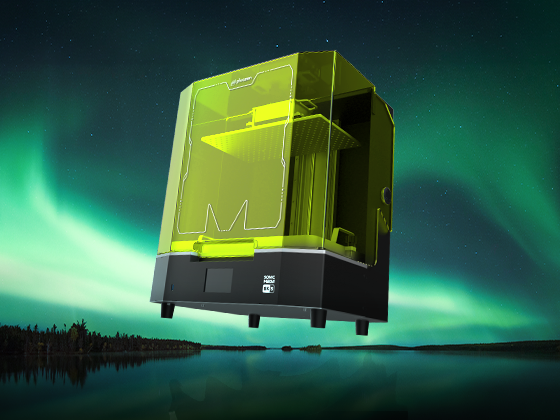
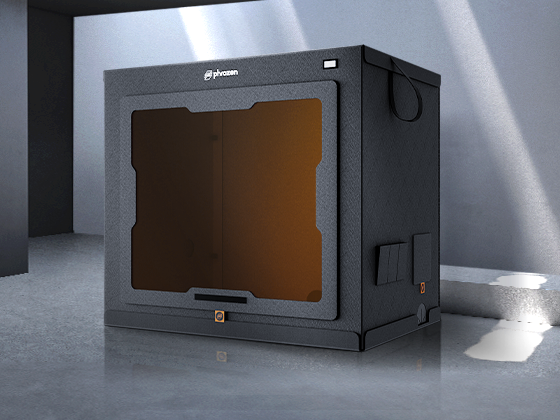
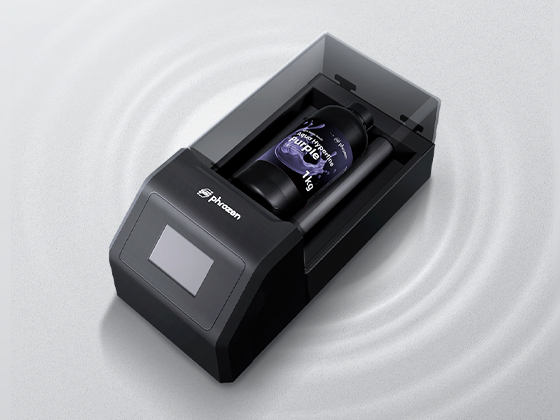
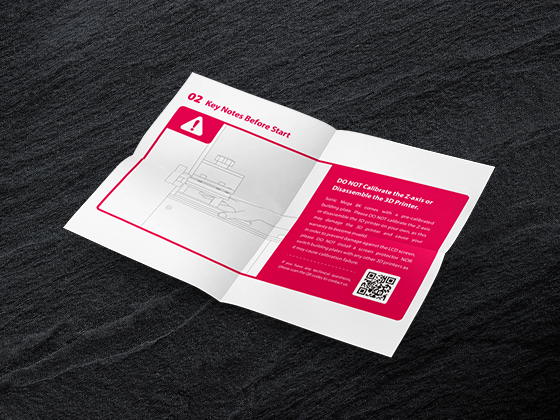
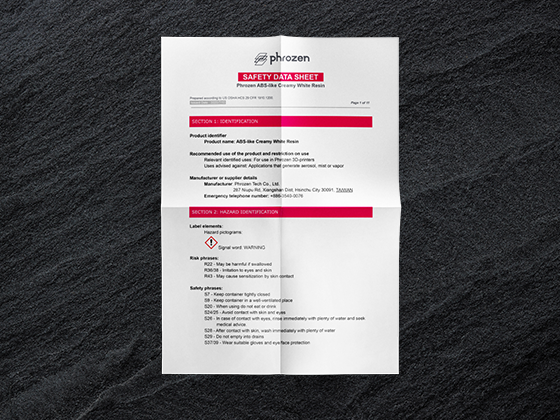
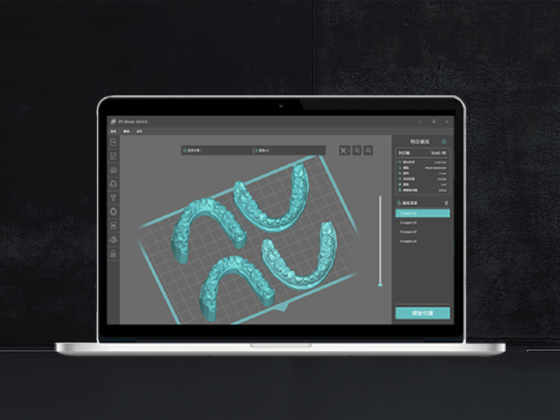
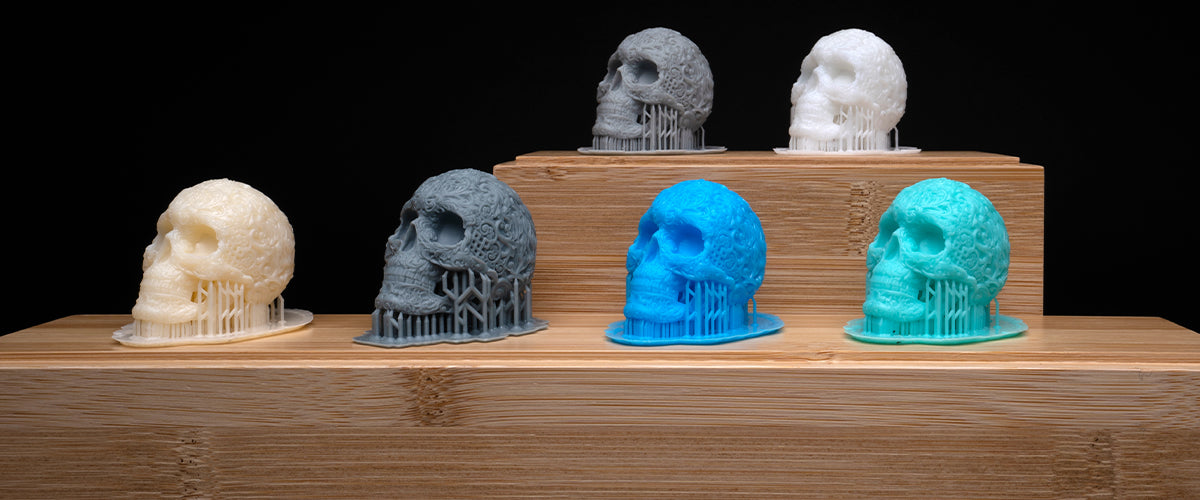
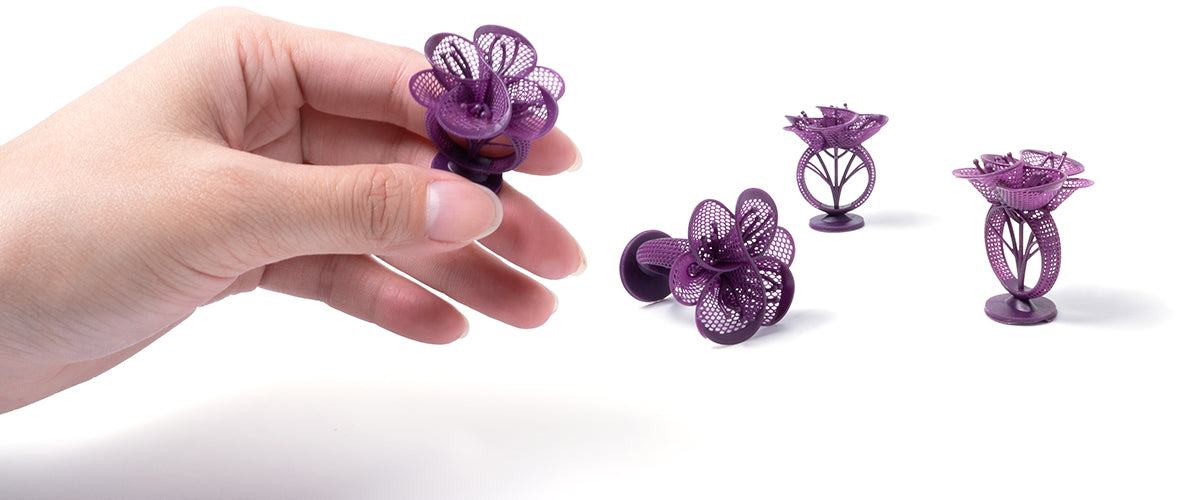
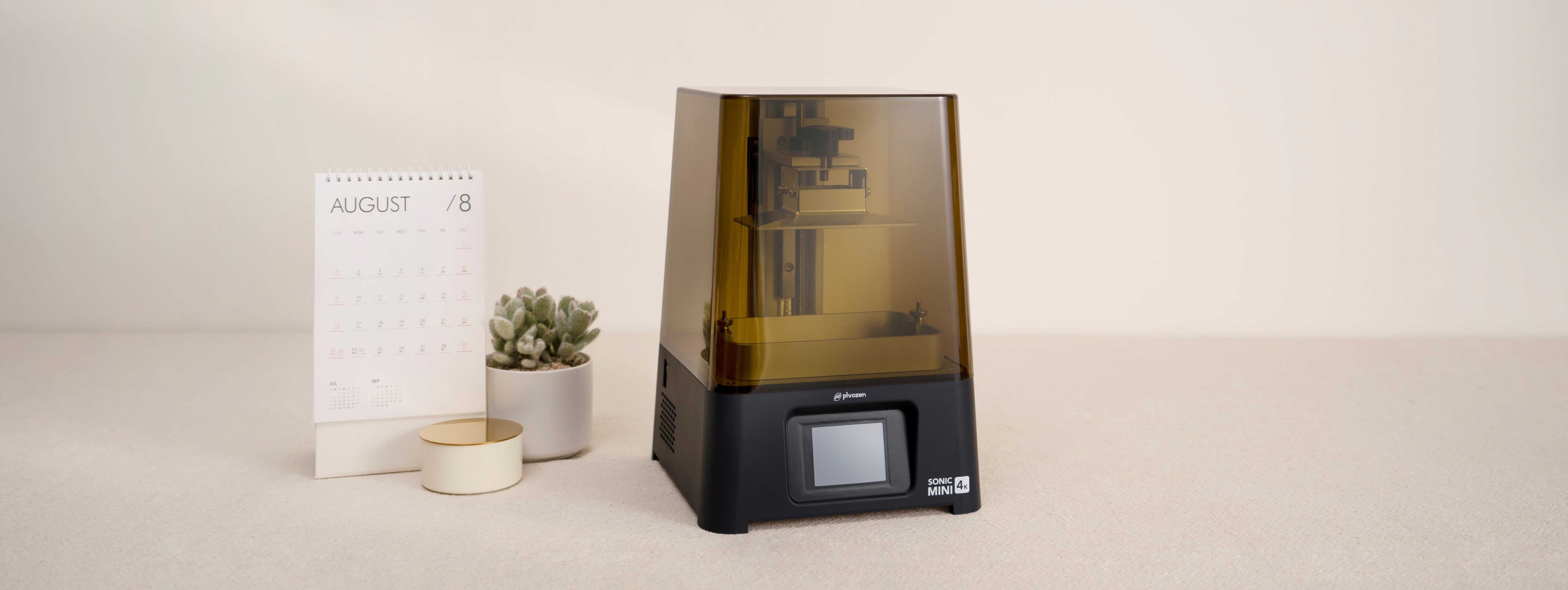
11 コメント
YUGUO
Hi,I want to ask Aqua-Gray 8K Resin’s Tg (Glass Transition Temperature),THANKS
———
Phrozen Technology replied:
Hello Yuguo, Thank you for commenting.
The Tg of the material was not in both the standard testing programme of our resin product, and the expected using scenario of the material. Thus we are not able to provide the data of what you are looking for.
Thank you.
Best, Phrozen Team
>
Hi,I want to ask Aqua-Gray 8K Resin’s Tg (Glass Transition Temperature),THANKS
———
Phrozen Technology replied:
Hello Yuguo, Thank you for commenting.
The Tg of the material was not in both the standard testing programme of our resin product, and the expected using scenario of the material. Thus we are not able to provide the data of what you are looking for.
Thank you.
Best, Phrozen Team
>
Gasper
I plan to purchase complete workflow for Mega 8k S
Resin 1:
I want to print large parts for motorcycles – meaning they need to have paint ready smooth surface and must be temperature resistant up to around 90°C, UV resistant and material must be appropriate for outdoor use.
Parts printed will be monocoques – hollow, and will be filled with various foams – will inner surface be fully cured during printing process ?
Which resin to use?
Can resin be colored prior printing if we would like to have it black, but other colors would perform better?
Resin 2:
Manufacturing molds for composite parts (Carbon)
Should have very smooth surface and resistant to 130°C for two hours at 5 bar of pressure. If not avalable, what is closest to that, since we can adopt curing cycle a bit.
What resin to use? how to temper (increase temperature resistance) it?
I need to know what spare parts are needed for continious prining of parts.
All info about workflow are highly appreciated.
Thanks, Gasper
———
Phrozen Technology replied:
Hi Gasper,
1. Resin printed objects are having smooth surface overall, especially when anti-aliasing is enabled. To achieve a smooth surface in resin printing depends on model design, orientation, and print parameters. Proper model preparation, orientation, and resin settings are crucial for optimal results.
2. For outdoor use, consider applying a UV-resistant prime spray after printing. Heat-resistant resins like Phrozen TR300 are suitable. However, the actual outdoor performance can be affected by complex environmental factors.
3. Hollow prints can be achieved through model design or settings in slicer software. Cure the interior part of a printed object with UV light of the same wavelength as post-curing is a necessary. Objects with uncured interiors may deform or break.
4. Based on your description, our initial judgment will recommend the Phrozen TR300 resin for its balance of properties.
5. Resin colouring is typically done after printing using paints or dyes. Each resin has its inherent colour; for example, TR300 is black, therefore the objects printed out using TR300 will be black.
6. TR300 has a heat deflection temperature of 156°C, suitable for industrial prototyping. For higher temperature resistance, consider Phrozen Dental Ortho Model Resin (190°C) or Ceramic White Resin which also has outstanding wear resistance, durability and temperature resistance.
7. Heat resistance is intrinsic to the resin’s material properties and can’t be externally altered.
8. For a printing farm, we suggest to keep extra releasing film, resin, and LCD screens. Use protective films on LCDs to prevent damage from resin leakage. Maintain stable humidity, temperature, and good ventilation in your working environment.
Feel free to contact our customer support for further assistance or detailed workflow information.
Best regards, Phrozen Team
>
I plan to purchase complete workflow for Mega 8k S
Resin 1:
I want to print large parts for motorcycles – meaning they need to have paint ready smooth surface and must be temperature resistant up to around 90°C, UV resistant and material must be appropriate for outdoor use.
Parts printed will be monocoques – hollow, and will be filled with various foams – will inner surface be fully cured during printing process ?
Which resin to use?
Can resin be colored prior printing if we would like to have it black, but other colors would perform better?
Resin 2:
Manufacturing molds for composite parts (Carbon)
Should have very smooth surface and resistant to 130°C for two hours at 5 bar of pressure. If not avalable, what is closest to that, since we can adopt curing cycle a bit.
What resin to use? how to temper (increase temperature resistance) it?
I need to know what spare parts are needed for continious prining of parts.
All info about workflow are highly appreciated.
Thanks, Gasper
———
Phrozen Technology replied:
Hi Gasper,
1. Resin printed objects are having smooth surface overall, especially when anti-aliasing is enabled. To achieve a smooth surface in resin printing depends on model design, orientation, and print parameters. Proper model preparation, orientation, and resin settings are crucial for optimal results.
2. For outdoor use, consider applying a UV-resistant prime spray after printing. Heat-resistant resins like Phrozen TR300 are suitable. However, the actual outdoor performance can be affected by complex environmental factors.
3. Hollow prints can be achieved through model design or settings in slicer software. Cure the interior part of a printed object with UV light of the same wavelength as post-curing is a necessary. Objects with uncured interiors may deform or break.
4. Based on your description, our initial judgment will recommend the Phrozen TR300 resin for its balance of properties.
5. Resin colouring is typically done after printing using paints or dyes. Each resin has its inherent colour; for example, TR300 is black, therefore the objects printed out using TR300 will be black.
6. TR300 has a heat deflection temperature of 156°C, suitable for industrial prototyping. For higher temperature resistance, consider Phrozen Dental Ortho Model Resin (190°C) or Ceramic White Resin which also has outstanding wear resistance, durability and temperature resistance.
7. Heat resistance is intrinsic to the resin’s material properties and can’t be externally altered.
8. For a printing farm, we suggest to keep extra releasing film, resin, and LCD screens. Use protective films on LCDs to prevent damage from resin leakage. Maintain stable humidity, temperature, and good ventilation in your working environment.
Feel free to contact our customer support for further assistance or detailed workflow information.
Best regards, Phrozen Team
>
Massimo
I have dental lab. I produce ,just dental cast for orthodontic aligner. I have two machines: sonic 4k xl plus and sonic mega 8k. Which resin is economic for these printers.
Regards
———
Phrozen Technology replied:
Hello Massimo,
Thank you for commenting. For dental products, please contact our dental product agent to get further information and assistance, by submit a request via this link.
https://dental.phrozen3d.com/pages/contact
Hope this helps and have a great day.
Best, Phrozen Team
>
I have dental lab. I produce ,just dental cast for orthodontic aligner. I have two machines: sonic 4k xl plus and sonic mega 8k. Which resin is economic for these printers.
Regards
———
Phrozen Technology replied:
Hello Massimo,
Thank you for commenting. For dental products, please contact our dental product agent to get further information and assistance, by submit a request via this link.
https://dental.phrozen3d.com/pages/contact
Hope this helps and have a great day.
Best, Phrozen Team
>
Dave Dening
I just finished my first print with TR300 using an Egloo Mars Pro. I’m impressed by the resin’s toughness in snapping off the supports. But, in cleaning up the printer there was a sticky layer even after a wash in 99% isopropyl alcohol. And, the prints were sticky even after a quick wash.
What can I use to clean off the resin left on the printer?
———
Phrozen Technology replied:
Hi Dave,
For cleaning the leftover resin, we recommend our customers to follow these steps. Firstly, spray 95% sanitizing alcohol, IPA onto the FEP or the PFA (nFEP) film. Then, use a soft kitchen paper towel or fiber cloth to clean the leftover resin. Repeat this step until the resin vat is clean and make sure to clean the edges as well. This will ensure that the resin vat is thoroughly cleaned and ready for the next use.
If you see cured resin particles scattered around the vat, please check your printer’s manual, and see if you can find any function like the vat cleaning that we provided with our printers. You can check out this article about vat cleaning function in our helpcentre: https://reurl.cc/pLgZW8
Hope you find this helpful!
Regards, Phrozen Team.
>
I just finished my first print with TR300 using an Egloo Mars Pro. I’m impressed by the resin’s toughness in snapping off the supports. But, in cleaning up the printer there was a sticky layer even after a wash in 99% isopropyl alcohol. And, the prints were sticky even after a quick wash.
What can I use to clean off the resin left on the printer?
———
Phrozen Technology replied:
Hi Dave,
For cleaning the leftover resin, we recommend our customers to follow these steps. Firstly, spray 95% sanitizing alcohol, IPA onto the FEP or the PFA (nFEP) film. Then, use a soft kitchen paper towel or fiber cloth to clean the leftover resin. Repeat this step until the resin vat is clean and make sure to clean the edges as well. This will ensure that the resin vat is thoroughly cleaned and ready for the next use.
If you see cured resin particles scattered around the vat, please check your printer’s manual, and see if you can find any function like the vat cleaning that we provided with our printers. You can check out this article about vat cleaning function in our helpcentre: https://reurl.cc/pLgZW8
Hope you find this helpful!
Regards, Phrozen Team.
>
Michael Lindsay
Hi,
I’m looking for a very opaque bright white resin. I’ve tried a few different brands but they do not print with enough detail (similar to the grey abs like). Some voids are filled in making the prints unusable for what I need them for.
Why are the grey resins the most suited to detailed prints? Is it due to the pigments blocking the excess light more efficiently or am I simply using the wrong settings.
Thanks
———
Phrozen Technology replied:
Hi Michael, if you are looking for gray resins that offer the highest result of details, then we recommend the Aqua-Gray 8K. You may also look into our Aqua-Gray 4K for another gray option or the BASF Protowhite for a bright, clean white resin.
Cheers, Phrozen Team
>
Hi,
I’m looking for a very opaque bright white resin. I’ve tried a few different brands but they do not print with enough detail (similar to the grey abs like). Some voids are filled in making the prints unusable for what I need them for.
Why are the grey resins the most suited to detailed prints? Is it due to the pigments blocking the excess light more efficiently or am I simply using the wrong settings.
Thanks
———
Phrozen Technology replied:
Hi Michael, if you are looking for gray resins that offer the highest result of details, then we recommend the Aqua-Gray 8K. You may also look into our Aqua-Gray 4K for another gray option or the BASF Protowhite for a bright, clean white resin.
Cheers, Phrozen Team
>
Shaneel
Hi,
What is the post curing time required for the resins TR300 & TR250 ?
———
Phrozen Technology replied:
Hi Shaneel, thanks for your comment! Please post-cure both TR300 & TR250 for at least 30 minutes to ensure the models are thoroughly cured.
Cheers, Phrozen Team
>
Hi,
What is the post curing time required for the resins TR300 & TR250 ?
———
Phrozen Technology replied:
Hi Shaneel, thanks for your comment! Please post-cure both TR300 & TR250 for at least 30 minutes to ensure the models are thoroughly cured.
Cheers, Phrozen Team
>
IRMAK
Hi, which resin is the most suitable for making the most durable/flexible 3D printed figurines or busts that will have a long shelf life?
———
Phrozen Technology replied:
Hey IRMAK,
Thank you for your comment! For best results, we would recommend Aqua-Gray 4K resin.
Cheers, Phrozen Team
Hi, which resin is the most suitable for making the most durable/flexible 3D printed figurines or busts that will have a long shelf life?
———
Phrozen Technology replied:
Hey IRMAK,
Thank you for your comment! For best results, we would recommend Aqua-Gray 4K resin.
Cheers, Phrozen Team
RAMI MOSLEM
What is suitable settings (Resin Profile) for using Washable Dental Models resin for producing high quality dental models and ditched dies using Sonic Mini 4K?
———
Phrozen Technology replied:
Hi there,
Thank you for your comment. Please refer to our resin profile page to find the answer to your question: https://phrozen3d.com/pages/resin-profile
What is suitable settings (Resin Profile) for using Washable Dental Models resin for producing high quality dental models and ditched dies using Sonic Mini 4K?
———
Phrozen Technology replied:
Hi there,
Thank you for your comment. Please refer to our resin profile page to find the answer to your question: https://phrozen3d.com/pages/resin-profile
Isaac
Hi, which resin would be best suited for printing very large parts (full build platforms on the Mega) that will be assembled / glued together to form a larger model? Specifically which resin would have the lowest deformation after curing so that alignment between pieces is easier?
Thanks,
———
Phrozen Technology replied:
Hi there,
Thank you for your comment! If you’re planning on printing out Industrial parts, we would recommend TR300 Resin. If you’re looking to print out action figurines or other 3D prints, we would recommend Aqua-Gray 4K or Aqua-Ivory 4K Resin.
Hi, which resin would be best suited for printing very large parts (full build platforms on the Mega) that will be assembled / glued together to form a larger model? Specifically which resin would have the lowest deformation after curing so that alignment between pieces is easier?
Thanks,
———
Phrozen Technology replied:
Hi there,
Thank you for your comment! If you’re planning on printing out Industrial parts, we would recommend TR300 Resin. If you’re looking to print out action figurines or other 3D prints, we would recommend Aqua-Gray 4K or Aqua-Ivory 4K Resin.
Phrozen Team
Hi there, thank you for your comment!
“ABS” stands for Acrylonitrile butadiene styrene which is a chemical compound used to create resins. Please refer to this link to learn more about our functional resins: https://phrozen3d.com/collections/functional-resins
Hi there, thank you for your comment!
“ABS” stands for Acrylonitrile butadiene styrene which is a chemical compound used to create resins. Please refer to this link to learn more about our functional resins: https://phrozen3d.com/collections/functional-resins
Bo R McCullough
This is very informative. What does ‘ABS’ stand for and which resins work best for applications requiring some flexibility?
This is very informative. What does ‘ABS’ stand for and which resins work best for applications requiring some flexibility?